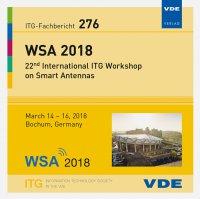Coded Caching in a Cell-Free SIMO Network
Konferenz: WSA 2018 - 22nd International ITG Workshop on Smart Antennas
14.03.2018 - 16.03.2018 in Bochum, Deutschland
Tagungsband: WSA 2018
Seiten: 8Sprache: EnglischTyp: PDF
Persönliche VDE-Mitglieder erhalten auf diesen Artikel 10% Rabatt
Autoren:
Bayat, Mozhgan; Mungara, Ratheesh K.; Caire, Giuseppe (Communications and Information Theory Group, Technische Universität Berlin, 10623 Berlin, Germany)
Inhalt:
The coded caching scheme proposed by Maddah-Ali and Niesen considers the delivery of files in a given content library to users through the so-called single bottleneck link network. While the single bottleneck link network is a deterministic errorfree model, where the multicast rate to all users is fixed irrespectively of the number of users, in order to apply this paradigm to a wireless network, it is important to make sure that the common rate at which the multicast message is transmitted remains large as the number of users increase. This paper focuses on a variant of the Maddah-Ali and Niesen scheme successively proposed for the so-called combination network, where the multicast message is further encoded by an MDS code and the MDS-coded blocks are simultaneously transmitted from different nodes, referred to in the wireless context of this paper as Remote Radio Heads (RRHs). In the proposed system, each user is equipped with an antenna array and can select to decode a certain number of RRH transmissions, while either zero-force some others, or simply treat the others (the weak ones) as noise. The system is “cell-free” in the sense that each user can independently and individually (in a user-centric manner) decide which RRHs to decode, without any explicit association of users to RRHs. We study the performance of the proposed system when users and RRHs are distributed according to 2-dimensional homogeneous Poisson Point Process and the propagation is affected by Rayleigh fading and distance dependent pathloss. We use stochastic geometry to derive the average rate of the typical user and the ergodic rate CDF, where ergodicity is with respect to the small-scale Rayleigh fading and the randomness of the rates is due to the large-scale pathloss, which is random due to the random geometry. Our analysis allows to optimize the system with respect to the MDS coding rate. Also, from our analysis it follows that the proposed system is fully scalable, in the sense that it can support an arbitrarily large number of users, while maintaining a non-vanishing peruser rate.


